





Published on Nov 30, 2023
The traditional mode of construction for individual houses comprising load bearing walls with an appropriate roof above or reinforced concrete (RC) framed structure construction with infill masonry walls would be totally inadequate for mass housing construction industry in view of the rapid rate of construction. Further, such constructions are prone to poor quality control even in case of contractors with substantial resources and experience. “For undertaking mass housing works, it is necessary to have innovative technologies which are capable of fast rate construction and are able to deliver good quality and durable structure in cost effective manner”. Several systems are adopted at different places in the world; eventually the systems which are reasonably economical and easy for operation with skilled labor are useful in India. Certain systems are in vogue and more and more contractors are trying to bring in new technologies. These are essentially based on the basis of mode of construction, namely, pre-cast construction or in-situ construction.
Pre-cast and cast-in-situ are techniques that are used for quick construction. Pre-cast includes the wall-panel units and slab units directly added to building structure. The use of aluminium also evolved as one of the technique for quick construction by use of aluminium and steel (tunnel) formwork. As a matter of fact the cost of the formwork may be up to 25% of cost of the structure in building work, and even higher in bridges, it is thus essential that the forms are properly designed to effect economy without sacrificing strength and efficiency. Certain patented systems based on imported technologies such as “Mascon System” (Canada), “Mivan System” (Malaysia) have come on the Indian scene in recent years.
In these systems traditional column and beam construction is eliminated and instead walls and slabs are cast in one operation at site by use of specially designed, easy to handle (with minimum labor and without use of any equipment) light weight pre-engineered aluminum forms. Rapid construction of multiple units of a repetitive type can be achieved with a sort of assembly line production by deployment of a few semi-skilled labors. The entire operation essentially comprises fitting and erecting the portion of shuttering as already determined (the optimization in use is determined by appropriate planning) and then carrying out concreting of the walls and slabs. Props are so designed that they stay in position while de-shuttering of slabs and/or takes place. The dimensional accuracy of the formwork is of high order. Therefore any possibility of errors does not rise.
An engineered system of building construction, namely “3-S” system was developed by B.G.SHIRKE CONSTRUCTION TECH LTD., for achieving, speed, strength, safety and economy in construction practices. The system involves structural elements such as pre-cast hollow column shells pre-cast concrete beams, light weighed reinforced cellular autoclaved concrete slabs for floor and roofs constituting the basic structural formwork. The “3-S” system involves activities for construction of building such as:
I. Cast in-situ sub-structure including foundations, stem columns, plinth beams, plinth masonry.
II. Erection of partial pre-cast components, jointing of these components using cast in-situ concrete with appropriate reinforcement.
III. Lying of reinforced cast in-situ screed over slab panels, construction of panels, construction of walling, flooring, plastering, water proofing etc.
Achieving the “3-S” system in the MIVAN formwork is quite easy. MIVAN formwork has got the unsurpassed speed of construction due to saving time for required time in masonry and plastering. The strength of raw aluminium is very less but when alloyed with other materials prove to be strong enough to use as a formwork. To ensure safety in the site, an integrated safety/ working platform is developed which ensures labor safety during erection and striking of the formwork. Economy is also one of the main factors of any system. The MIVAN formwork proves to cost efficient as it can be used efficiently for 250 times.
When concrete is placed, it is in plastic state. It requires to be supported by temporary supports and castings of desired shape till it becomes sufficiently strong to support its own weight. This temporary casing is known as the formwork or forms or shuttering. The term moulds is sometimes used to indicate formwork of relatively small units such as lintels, cornices etc.
Formwork can be classified according to a variety of categories, relating to the differences in sizes, the location of use, construction materials, nature of operation, or simply by the brand name of the products. However, the huge amount of tropical wood being consumed each year for formwork has resulted in criticism from environmentalists, as well as the continual escalation of timber prices. As a result, there has been a strong tendency to use other formwork materials or systems to replace timber. The different categories in which formwork can be classified are:
a) According to size.
b) According to location of use.
c) According to materials of construction.
d) According to nature of operation.
e) According to brand name of the product.
The system of aluminum forms (MIVAN) has been used widely in the construction of residential units and mass housing projects. It is fast, simple, adaptable and cost – effective. It produces total quality work which requires minimum maintenance and when durability is the prime consideration. This system is most suitable for Indian condition as a tailor–made aluminum formwork for cast–in–situ fully concrete structure.
Mivan is basically an aluminium formwork system developed by one of the construction company from Europe. In 1990, the Mivan Company Ltd from Malaysia started the manufacturing of such formwork systems. Now a days more than 30,000 sq m of formwork used in the world are under their operation. In Mumbai, India there are number of buildings constructed with the help of the above system which has been proved to be very economical and satisfactory for Indian Construction Environment.
The technology has been used extensively in other countries such as Europe, Gulf Countries, Asia and all other parts of the world. MIVAN technology is suitable for constructing large number of houses within short time using room size forms to construct walls and slabs in one continuous pour on concrete. Early removal of forms can be achieved by hot air curing / curing compounds. This facilitates fast construction, say two flats per day. All the activities are planned in assembly line manner and hence result into more accurate, well – controlled and high quality production at optimum cost and in shortest possible time.
In this system of formwork construction, cast – in – situ concrete wall and floor slabs cast monolithic provides the structural system in one continuous pour. Large room sized forms for walls and floors slabs are erected at site. These forms are made strong and sturdy, fabricated with accuracy and easy to handle. They afford large number of repetitions (around 250). The concrete is produced in RMC batching plants under strict quality control and convey it to site with transit mixers.
The frames for windows and door as well as ducts for services are placed in the form before concreting. Staircase flights, façade panels, chajjas and jails etc. and other pre-fabricated items are also integrated into the structure. This proves to be a major advantage as compared to other modern construction techniques.
The method of construction adopted is no difference except for that the sub – structure is constructed using conventional techniques. The super–structure is constructed using MIVAN techniques. The integrated use the technology results in a durable structure.
The formwork system is precisely-engineered system fabricated in aluminium. Using this system, all the elements of a building namely, load bearing walls, columns, beams, floor slabs, stairs, balconies etc can be constructed with cast in place concrete. The resulting structure has a good quality surface finish and accurate dimensional tolerances. Further, the construction speed is high and the work can be done in a cost effective manner.
The modular nature of the formwork system allows easy fixing and removal of formwork and the construction can proceed speedily with very little deviation in dimensional tolerances. Further, the system is quite flexible and can be easily adapted for any variations in the layout.
The availability of concrete from ready mix concrete facility has augured well for the use of this work system. However, the proliferation of RMC facilities in the cities in India and the willingness to use mechanized means of transport and placing of concrete, the use of aluminium formwork system has received a boost. The quality of the resulting concrete is found to be superior.
Structurally speaking, the adoption of the closed box system using monolithic concrete construction has been found to be the most efficient alternatives. The stresses in both the concrete and steel are observed to be much lower even when horizontal forces due to wind or earthquake are taken into consideration.
The formwork system can be used for construction for all types of concrete systems, that is, for a framed structure involving column beam –slab elements or for box-type structure involving slab-walls combination.
The basic element of the formwork is the panel, which is an extruded aluminium rail section, welded to an aluminium sheet. This produces a lightweight panel with an excellent stiffness to weight ratio, yielding minimal deflection under concrete loading. Panels are manufactured in the size and shape to suit the requirements of specific projects.
The panels are made from high strength aluminium alloy with a 4 mm thick skin plate and 6mm thick ribbing behind to stiffen the panels. The panels are manufactured in MIVAN’S dedicated factories in Europe and South East Asia. Once they are assembled they are subjected to a trial erection in order to eliminate any dimensional or on site problems.
All the formwork components are received at the site whining three months after they are ordered. Following are the components that are regularly used in the construction.
It forms the face of the wall. It is an Aluminium sheet properly cut to fit the exact size of the wall
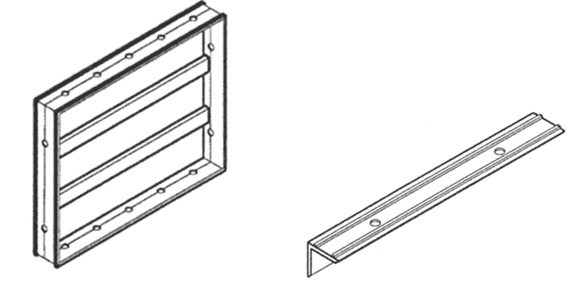
It is a supporting component of wall. It is L-shaped panel having allotment holes for stub pin.
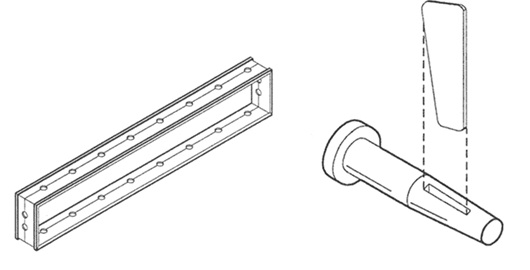
It forms the wall face at the top of the panels and acts as a ledge to support
It helps in joining two wall panels. It helps in joining two joints
MIVAN aims in using modern construction techniques and equipment in all its projects. On leaving the MIVAN factory all panels are clearly labeled to ensure that they are easily identifiable on site and can be smoothly fitted together using the formwork modulation drawings. All formwork begins at a corner and proceeds from there.
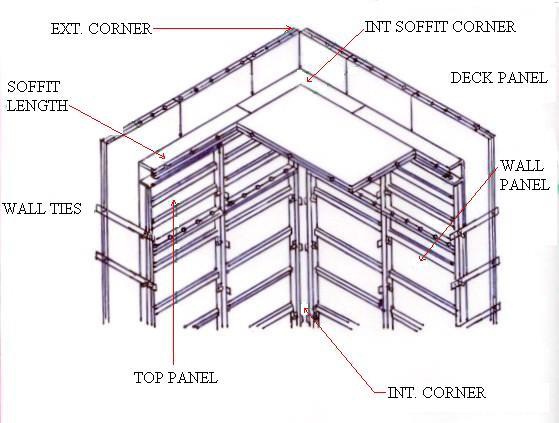
FIG: - WALL ASSEMBLY DETAILS
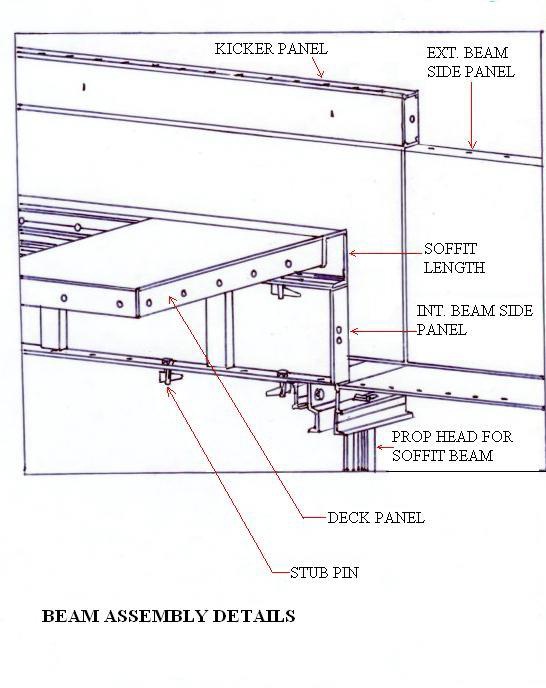
The construction activities are divided as pre – concrete activities, during concreting and post – concrete activities. They are as follows:
a) Receipt of Equipment on Site – The equipments is received in the site as ordered.
b) Level Surveys – Level checking are made to maintain horizontal level check.
c) Setting Out – The setting out of the formwork is done.
d) Control / Correction of Deviation – Deviation or any correction are carried out.
e) Erect Formwork – The formwork is erected on site.
f) Erect Deck Formwork – Deck is erected for labours to work.
g) Setting Kickers – kickers are provided over the beam.
After the above activities have been completed it is necessary to check the following.
i. All formwork should be cleaned and coated with approved realize agent.
ii. Ensure wall formwork is erected to the setting out lines.
iii. Check all openings are of correct dimensions, not twist.
iv. Check all horizontal formwork (deck soffit, and beam soffit etc.) in level.
v. Ensure deck and beam props are vertical and there is vertical movement in the prop lengths.
vi. Check wall ties, pins and wedges are all in position and secure.
vii. Any surplus material or items to be cleared from the area to be cast.
viii. Ensure working platform brackets are securely fastened to the concrete.
At least two operatives should be on stand by during concreting for checking pins, wedges and wall ties as the pour is in progress. Pins, wedges or wall ties missing could lead to a movement of the formwork and possibility of the formwork being damaged. This – effected area will then required remedial work after striking of the formwork.
Things to look for during concreting:
i. Dislodging of pins / wedges due to vibration.
ii. Beam / deck props adjacent to drop areas slipping due to vibration.
iii. Ensure all bracing at special areas slipping due to vibration.
iv. Overspill of concrete at window opening etc.
i) Strike Wall Form- It is required to strike down the wall form.
ii) Strike Deck Form- The deck form is then removed.
iii) Clean, Transport and stack formwork
iv) Strike Kicker Formwork – The kicker are removed.
v) Strike wall – Mounted on a Working Platform the wall are fitted on next floor.
vi) Erect Wall – Mount Working Platform and the wall is erected.
Normally all formwork can be struck after 12 hours.
The post – concreting activities includes:
All components should be cleaned with scrapers and wire brushes as soon as they are struck. Wire brush is to be used on side rails only. The longer cleaning is delayed, the more difficult the task will be. It is usually best to clean panels in the area where they are struck.
There are basic three methods recommended when transporting to the next floor:
i. The heaviest and the longest, which is a full height wall panel, can be carried up the nearest stairway.
ii. Passes through void areas.
iii. Rose through slots specially formed in the floor slab for this purpose. Once they have served their purpose they are closed by casting in concrete filter.
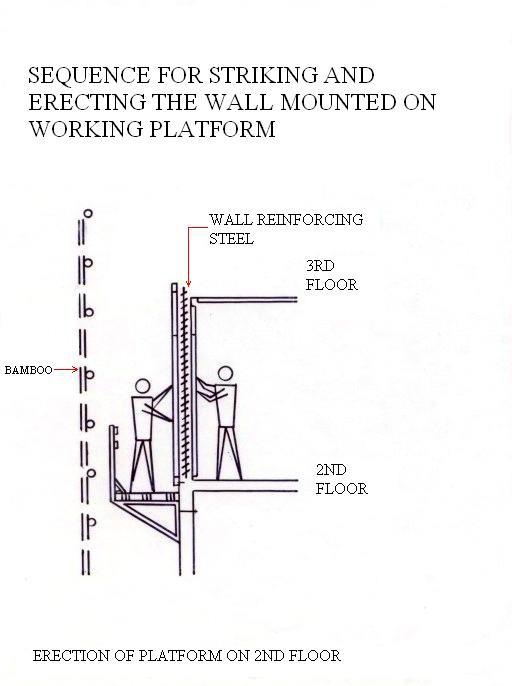
Once cleaned and transported to the next point of erection, panels should be stacked at right place and in right order.
Proper stacking is a clean sign of a wall – managed operation greatly aids the next sequence of erection as well as prevents clutters and impend other activities.
The formwork is designed using the most economical assortment of panel sizes with the help of the state-of-the art design software. The use of the software along with the experience and skill of the designers ensures an efficient construction process by incorporating the optimum assembly procedures, economical panel selection and ultimately minimizing capital and operational costs.
The formwork requirement depends upon various parameters such as desired speed of construction, economy required. After considering all of these, various options are offered at the estimate stage to the client. The system is flexible in design and can form any architectural or structural configuration, such as stairs, bay windows, curved features etc. Designers consult the architects and structural designers during design stage in order to avoid costly modifications of RC members during construction stage.
It is thus essential to select the most practical and economic blend of standard formwork components required for the building at the preconstruction design phase itself.
Using Bespoke design software, the formwork is designed using the most economical assortment of panel sizes. The combination of bespoke software and the experience of MIVAN designer’s guarantees:-
a) Most efficient construction process incorporating the optimum assembly procedures.
b) Economical panel section.
c) Ultimately minimizing capital and operational cost.
MIVAN is a system for scheduling & controlling the work of other connected construction trades such as steel reinforcement, concrete placements & electrical inserts. The work at site hence follows a particular sequence. The work cycle begins with the deshuttering of the panels. It takes about 12-15hrs. It is followed by positioning of the brackets & platforms on the level. It takes about 10-15hrs simultaneously.
The deshuttered panels are lifted & fixed on the floor .The activity requires 7-10 hrs.Kicker & External shutters are fixed in 7 hrs. The wall shutters are erected in 6-8 hrs One of the major activity reinforcement requires 10-12 hrs. The fixing of the electrical conduits takes about 10 hrs and finally pouring of concrete takes place in these.
This is a well synchronized work cycle for a period of 7 days. A period of 10-12 hrs is left after concreting for the concrete to gain strength before the beginning of the next cycle. This work schedule has been planned for 1010-1080 sq m of formwork with 72-25cu m of concreting & approximate reinforcement.
The formwork assembling at the site is a quick & easy process. On leaving the MIVAN factory all panels are clearly labeled to ensure that they are easily identifiable on site and can be smoothly fitted together using formwork modulation drawings. All formwork begins from corners and proceeds from there.
The system usually follows a four day cycle: -
Day 1: -The first activity consists of erection of vertical reinforcement bars and one side of the vertical formwork for the entire floor or a part of one floor.
Day 2: -The second activity involves erection of the second side of the vertical formwork and formwork for the floor
Day 3: - Fixing reinforcement bars for floor slabs and casting of walls and slabs.
Day 4: -Removal of vertical form work panels after 24hours, leaving the props in place for 7 days and floor slab formwork in place for 2.5 days.
Comparative costs of building using load bearing wall and slab system and conventional framed system of column, beams, slab for the construction of a ground-plus-seven building is given in Table 3.8.1. It can be seen that the total cost of ground-plus-seven building using MIVAN System is Rs.5344/m² which is lower than that in conventional system is Rs.6034/m².
The cost per flat (or per m² built up area) using MIVAN shuttering system depends upon the number of repetition and period of completion of the project. As the formwork can be reused over 250 times, the initial cost per unit of forming area is less when compared to traditional methods. The reduction of cost is also due to the elimination of brickwork and plaster and also due to reduction in time. The cost of the project gets substantially reduced due to shear wall construction. These are due to the reduced consumption of steel, masonry, and plaster even though the use of concrete decreases. For the same number of repetition, the cost will be less if the period of completion is longer. This is because for a shorter completion period, the area of formwork is more than required for longer completion period.
The aluminium formwork provides an integrated scaffolding system which reduces the cost of scaffolding requirements. The mechanical and electrical installation is simplified as conduits are embedded in the structure by precise engineering of outlets and service ducts.
Thus, we can conclude that the overall cost of the project is lesser when compared to project using traditional methods of formwork.
The task of housing due to the rising population of the country is becoming increasingly monumental. In terms of technical capabilities to face this challenge, the potential is enormous; it only needs to be judiciously exploited.
Civil engineers not only build but also enhance the quality of life. Their creativity and technical skill help to plan, design, construct and operate the facilities essential to life. It is important for civil engineers to gain and harness the potent and versatile construction tools.
Traditionally, construction firms all over the world have been slow to adopt the innovation and changes. Contractors are a conservative lot. It is the need of time to analyze the depth of the problem and find effective solutions. MIVAN serves as a cost effective and efficient tool to solve the problems of the mega housing project all over the world. MIVAN aims to maximize the use of modern construction techniques and equipments on its entire project.
This technology has great potential for application in India to provide affordable housing to its rising population. Thus it can be concluded that quality and speed must be given due consideration with regards to economy. Good quality construction will never deter to projects speed nor will it be uneconomical. In fact time consuming repairs and modification due to poor quality work generally delay the job and cause additional financial impact on the project. Some experts feel that housing alternatives with low maintenance requirements may be preferred even if at the slightly may preferred even if at the higher initial cost.
1. Carol., A., “(2001)”. Editor. “Times Journal Construction and Design”. Oct-Dec 2001, pp Editorial.
2. “Census of India”., “(2001)” “Table 500-012”. pp-48.
3. Jain and Jain., “(1993)”. “Design of Formwork”. “Design of Concrete Structures.”, Edition 1993, pp 595-606.
4. Jana., V., G., & Kagale., Y., P., “(2005)”. “Indegnisation of Mass housing technology”. “Indian Concrete Journal”, July2005, Volume 79, pp. 41-46.
5. Kulkarni., D., V., “(2001)”. “ First Rate Forms”. “Times Journal Construction and Design”. Oct-Dec 2001, pp 22-23.
| Are you interested in this topic.Then visit the below page to get the full report |